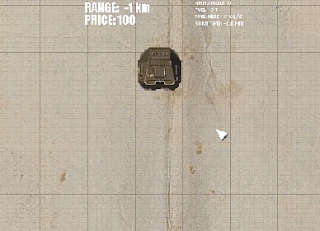Set in a fictional realm that has strong parallels to central Asia, HighFleet places the player in the role of a commanding officer of royal lineage. It's all very in medias res, with lots of in-fiction terms being thrown around during dialogue segments. Simply put though, the objective is to recapture a land that has rebelled against its former conquers. Things go sidewise at the end of the prologue though when news comes that the distant homeland capital of the player's invasion force has been obliterated by a nuclear strike. Having little in the way of options, it's up to you to carve a kingdom out of the chaos. Sounds difficult, right? Well...it is, but the player does have a squadron of flying battleships at their disposal...
To be specific, HighFleet is all about methane-fueled rocket-powered airships that are bristling with missiles launchers and large caliber guns. Gameplay itself is split into three distinct layers. The topmost is a strategic display that gives a 2D birds-eye view (actually more of a spy satellite view, but you get the idea...). From here the player can inspect the map and navigate their forces through a rugged and barren landscape marked by a network of towns. Each of these points of interest has a specialization. Some towns provide better repairs, others cheaper fuel, useful upgrade materials, valuable intel, or purchasable airships to augment the player's military might. Each town also has a garrison that must be eliminated in order to utilize the town's features.These tactical engagements take the form of battles viewed in (once again) 2D, but this time they are shown from the side. The player can only field one airship at a time (which they control directly), but the enemy can have up to three vessels active on screen. Reinforcements arrive on the edges of the screen with an order of appearance set by each side for their own respective units before the battle begins. To mitigate the apparent unfairness, there are several things that the player can use to their advantage. For one there is a retreat point; randomly chosen somewhere along the top or far edge of the screen each battle. The player can use this to withdraw a damaged unit or one that has expended it's missiles. Enemy units also show where they are going to fire shortly before doing so, thus giving the player a chance to dodge provided the airship they are currently controlling is somewhat agile. Friendly fire is another way the player can turn being out numbered into an advantage. I've had more than a few enemies destroy one of their own teammates with misdirected ordinance.
The final layer of gameplay takes place mostly in cities (or perhaps more accurately described as a semi-linear series of story an managerial events) happening periodically throughout the game. Here, the player chooses from one of several dialogue or decision options that can affect their standing with NPCs, as well as the overall moral of the men under their command. One other important feature here is the ability to recruit "tarkhans" (essentially rogue warlords with powerful ships and connections of their own). Persuading them to join can be tricky though in that it typically takes the form of a mini-card game. Figuring out what cards to choose involves a lot of trial and error, and what cards the player has available is dependent on certain character traits they unlock through those aforementioned decision events. Aside from all that there is the management side of things: repairs, refueling, modifications, salvage, etc.Overall, there are a number of interlocking systems at play that need to be mastered in order to win. I should also mention HighFleet is really hard. Enemy strike groups patrol between cities and have the firepower and determination to make things very difficult, especially when they are backed up by a tactical group outfitted with long-range missiles or a complement of conventional jet fighter/bombers. Of course, the player can get these weapon systems too...although using them effectively involves judicious application of radar which is a whole game of cat-and-mouse unto itself. On top that, intercepting and (sometimes) decoding enemy transmissions can give the player vital clues on how best to proceed to their ultimate goal of seizing the region capital. Oh, and there's nukes...maybe don't use them...at least not until the end.
I think it's easy to come away with the impression that HighFleet is a surprisingly original game, but in fact it bears more than a passing resemblance to two other old, lesser known MicroProse titles: Sid Meyer's Pirates! and the Ancient Art of War in the Skies. There's even some optional Lunar Lander thrown in for good measure. The setting feels very similar "Dune" by Frank Herbert. Similarities to other media aside, I really like the general aesthetic of the world. The music and sound, the analogue switches and buttons that make up the interface, even the slightly glitchy vacuum tube display add to the experience and help make the world feel alive. It's also my understanding that the game was made almost entirely by two guys living in Russia. If so, a tip of the hat to them. HighFleet is an impressive accomplishment for such a small team.



No comments:
Post a Comment